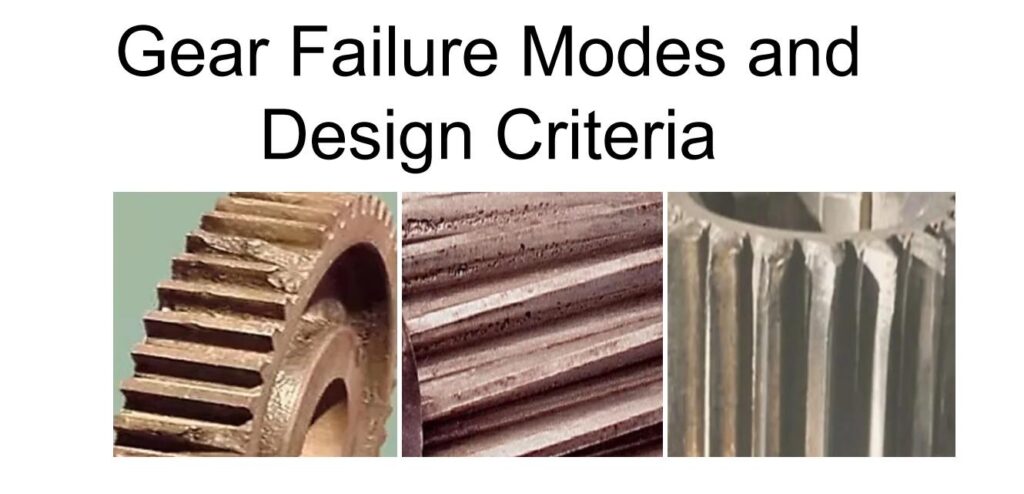Before designing any component, it is essential to understand its failure modes to determine the appropriate design criteria. This article provides a brief introduction to the failure modes of gears and their corresponding design criteria.
The Main Failure Modes of Gears
The failure of gear transmissions primarily refers to the failure of gear teeth. There are various failure modes, with the most common ones including: tooth breakage, pitting, surface wear, scoring, and plastic deformation.
- Tooth breakage, can occur in several forms. However, there are two primary causes of tooth breakage: root bending fatigue fracture (the main form of breakage under normal conditions) and overload breakage or shear, which may occur when the gear teeth experience sudden overloading.
There are four main measures to improve the resistance of gear teeth to breakage:
- Increase the fillet radius at the tooth root, eliminate machining marks, and reduce stress concentration at the tooth root.
- Increase the stiffness of the shaft and its support to ensure more uniform loading along the contact line of the gear teeth.
- Use appropriate heat treatment to ensure the core material of the gear teeth has sufficient toughness.
- Apply surface hardening processes such as shot peening and rolling to the tooth root.
2. Pitting, manifests as spot-like or even sheet-like flaking on the surface of the teeth. Since gear meshing involves line contact, the contact stress at local positions is very high, leading to alternating contact stress during meshing. Pitting is a phenomenon where the material on the tooth surface undergoes fatigue-induced spot damage due to this alternating contact stress. As observed, pitting mainly occurs in the middle of the tooth.
Initially, pitting appears as tiny pinhead-sized spots. However, if the working conditions are not improved, these spots will gradually expand and may even merge into larger areas, causing significant surface damage to the teeth.
There are four measures to improve the resistance of the tooth surface to pitting:
- Increase the hardness of the tooth surface material.
- Use appropriate lubrication to reduce contact stress.
- Within reasonable limits, increase the gear diameter to reduce contact stress.
- Within reasonable limits, use higher viscosity lubricating oil to prevent thinner oil from entering fatigue cracks and accelerating their propagation.
3. Surface Wear. During gear meshing, pure rolling occurs only at the pitch point, while friction exists between the tooth surfaces at other positions, making it easy for wear to occur. When impurities get mixed in between the tooth surfaces, wear accelerates. Therefore, surface wear refers to the failure mode where the tooth surface gradually wears down due to the presence of abrasive substances (such as iron filings, sand particles, etc.) between the meshing surfaces, ultimately leading to gear failure.
There are three measures to improve the resistance of the tooth surface to wear:
- Increase the hardness of the tooth surface material.
- Use enclosed gear transmissions and ensure proper lubrication.
- Keep the working environment of the gear transmission as clean as possible.
4. Gear surface adhesive wear, occurs when grooves form along the sliding direction on the tooth surface. This phenomenon leads to intense wear and heat generation, causing uneven transmission and ultimately resulting in gear failure.
For high-speed and heavy-load gear transmissions, where the transmission speed is fast and the instantaneous temperatures are high, the oil film can easily rupture. This can lead to localized welding and adhesion of materials on the tooth surface, known as adhesive wear. During this process, despite relative sliding between the tooth surfaces, the adhesive material is torn apart, leaving scars along the direction of relative sliding. This type of damage is referred to as gear surface adhesive wear, or thermal welding.
For low-speed and heavy-load gear transmissions, where there is high pressure between tooth surfaces and low transmission speeds, the formation of an oil film is difficult, leading to cold welding or adhesive wear.
There are three measures to improve the resistance of the tooth surface to adhesive wear:
- Increase the hardness of the tooth surface and reduce surface roughness.
- Use high-viscosity lubricating oil for low-speed transmissions and lubricating oil with anti-adhesive additives for high-speed transmissions.
- Ensure there is an appropriate hardness difference between paired gears.
5. Plastic deformation. On the left side, there is convex plastic deformation, while on the right side, there is concave plastic deformation.
Plastic deformation occurs when the material on the gear tooth surface enters a yielding state under excessive stress and undergoes plastic flow under tangential forces on the tooth surface.
To mitigate or prevent plastic deformation of gear teeth, increasing the hardness of the tooth surface and using high-viscosity lubricating oil or lubricants with extreme pressure additives are effective measures.
The above five failure modes can be categorized into two main classes: structural failure (tooth breakage) and surface failure (the other four types). Among these, tooth breakage is the most severe form of damage. Apart from tooth failure, other parts of the gear (such as the rim, spokes, hub, etc.) may also experience failure. However, these parts are typically designed with ample margins of safety in terms of strength and stiffness, based on empirical design practices. As a result, failures in these parts are rare in practice.
Gear Design Criteria
For general gear transmissions under typical operating conditions, the design criteria are as follows:
- Ensure sufficient root bending fatigue strength to prevent tooth root breakage.
- Ensure sufficient surface contact fatigue strength to prevent pitting.
Extensive engineering practice has shown that meeting these two design criteria can prevent the five failure modes mentioned earlier. Additionally, for high-speed and heavy-load gear transmissions, design should also consider criteria for resisting adhesive wear on the tooth surface.
It should be noted that for enclosed soft-face gear transmissions, the emphasis is on ensuring surface contact fatigue strength. For enclosed hard-face or open gear transmissions, the emphasis is on ensuring root bending fatigue strength.
Thank you for reading. Looking forward to serving you with our exceptional gear solutions. #BeyondGears
Read More:


